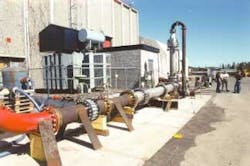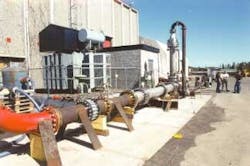In-line separation technique brings big efficiency gains for Statoil
Nick Terdre
Contributing Editor
Statoil has achieved substantial improvements in offshore processing through the development of in-line separation technology.
Simple, compact, and flexible, the technology can be retrofitted to existing separation systems as well as being tailored to newbuild systems. In the future, it will be further developed for subsea application.
"In-line technology represents nothing less than a revolution in upstream oil and gas separation," says Vidar Sørensen, sector manager in Statoil's process design group, which came up with the original idea. "I strongly believe we are on the verge of a technological breakthrough which will eventually make platforms obsolete."
The technology, which has been patented, cost NKr 15-20 million to develop. It enables liquids and gas to be separated within a section of pipe, and comes in two forms: the degasser, in which gas is removed from a liquid flow, and the deliquidizer, in which liquids are removed from a gas flow. As the flow enters the degasser or deliquidizer, it passes through a swirl device that sets it rotating. Centrifugal forces come into play that take the heavier components – the liquids – out to the wall of the pipe while the gas remains in the middle.
In the degasser, the gas then passes into a separate pipe that is routed vertically up and out of the main section of pipe, while the liquids flow ahead and pass through an anti-swirl device. In the deliquidizer, the liquids are collected and removed from the main pipe by passing them into a separate pipe that is then routed vertically downward and out of the main pipe.
Diagram showing how the in-line degasser functions to separate and remove gas from the liquid flow.
To achieve efficient separation, a certain pressure and velocity must be imparted to the flow as it is set rotating. The design of the swirl device achieves this objective, Sørensen says. The design group took several weeks to obtain a good understanding of the physics of the process – the relations between flow pattern, velocities, pressure drops, and pressure balances.
Another key challenge was the development of the control system, which monitors various parameters of the flow in the pipe through pressure, level, and other sensors. In the degasser the main functions of the control system are to control in real time the level of liquid in the vertical section of pipe and to ensure that it does not rise high enough to overflow into the open top of the gas pipe.
Statfjord slugging
Practical problems on the Statfjord B platform in the North Sea prompted the development of in-line technology. There, the full flow of wellstream fluids into the water treatment system was causing vibration due to slugging and had to be choked back. The in-line separator was conceived for use in combination with the existing separation equipment.
Once the concept had been developed, a series of tests qualified the system. A basis test with a 6-in. pipe, a verification test using 11-in. pipe, and a full-scale test with 18-in. pipe were performed at Kværner Eureka's test site at Tranby, near Oslo. These tests showed that both the degasser and the deliquidizer could achieve an efficiency of separation of at least 90%.
A degasser unit has now been built – in duplex steel – for Statfjord B. It was installed during the summer and will be tested in the autumn. By enabling process capacity to be more fully used, Statoil expects a production gain of up to 30%. The degasser should also end the mechanical problems caused by slugging, which is largely eliminated in the in-line separator. The reconfiguration of facilities will also make it possible to recover a significant volume of gas from produced water currently sent to the flare. Reduction of flaring and emissions is an important part of Statoil's zero-emissions policy, Sørensen points out.
null
Statoil is gaining operational experience of the deliquidizer from a prototype 14-in. unit on its Sleipner T platform, which processes the output from the Sleipner West field. The technology has attracted the attention of other operators, two of which have been provided with units for trial purposes. One, a degasser, will be tested on an oilfield in Oman, and the other, a deliquidizer, will be installed on a North Sea field. Each unit must be tailored to the application, taking into account such parameters as pressure, temperature, and the composition of the hydrocarbons.
The in-line separator is simple in design and construction, making it relatively inexpensive. It has no moving parts, which enhances its reliability, and it is relatively small and light. The 18-in. unit used for the full-scale test is 5 to 8 m long and weighs just 3 to 4 metric tons. As operational pressures increase, weight savings rise as well, compared with a conventional separator.
In comparison with the large and heavy separation tanks used offshore today, the in-line separator is relatively compact and lightweight. A newbuild configuration would include a conventional separator but would be smaller than if used without the in-line technology. Statoil believes that by incorporating the new technology, it should be possible to reduce the topside weight, space, and cost.
The new technology's compactness also makes it flexible for retrofit applications. The efficiency and capacity of existing equipment could be improved by installing a unit upstream of the existing equipment to provide a pre-separation process. Another scenario could be to place a unit downstream of each wellhead. A deliquidizer unit could be installed upstream of the scrubber to enhance the drying of the gas before it enters the compressor.
The Statoil design group now has its sights set on a number of aims for further development of the technology:
- Three-phase in-line degassing
- Achieving the dewpoint requirement for gas conditioning and/or export
- Qualification for subsea use.
A stringent technology requirement program has been drawn up to qualify the system for subsea use. In this case, the in-line technology would be used on its own. More experience needs to be gained from use of the system topsides first, Sørensen says, so development for subsea use is likely to have to wait a year or two.

